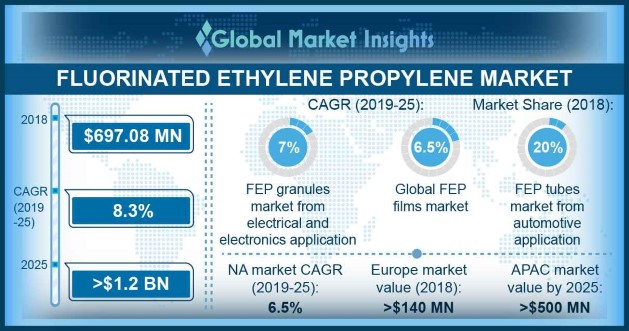Home > Chemicals & Materials > Polymers > Industrial Polymers > Fluorinated Ethylene Propylene (FEP) Market
Fluorinated Ethylene Propylene (FEP) Market Size
- Report ID: GMI3263
- Published Date: Apr 2019
- Report Format: PDF
Fluorinated Ethylene Propylene Market Size
Fluorinated Ethylene Propylene (FEP) Market size valued at USD 695 million in 2018 and will expect consumption of over 40 kilo tons by 2025.
Growing power demand, awareness of renewable energy and decreasing solar energy price should stimulate fluorinated ethylene propylene market share on account of growing adoption of solar photovoltaic panels. Global solar photovoltaic manufacturing sector surpassed USD 90 billion in 2018 which indicates tremendous growth opportunities.
| Report Attribute | Details |
|---|---|
| Base Year: | 2018 |
| Fluorinated Ethylene Propylene Market Size in 2018: | 695 Million (USD) |
| Forecast Period: | 2019 to 2025 |
| Forecast Period 2019 to 2025 CAGR: | 8.3% |
| 2025 Value Projection: | 1.2 Billion (USD) |
| Historical Data for: | 2014 to 2018 |
| No. of Pages: | 330 |
| Tables, Charts & Figures: | 452 |
| Segments covered: | Product and Region |
| Growth Drivers: |
|
| Pitfalls & Challenges: |
|
These materials improve processability, moisture barrier, temperature resistance, UV resistance and transparency of energy generating devices. Favorable government initiatives, rising diesel & electricity prices and rising demand for energy self-sufficiency should further promote the market growth.
Significant population growth, and increasing urbanization are likely to increase product adoption pertaining to the rise in power demand for commercial & residential property construction. Global construction sector may surpass USD 15 trillion by 2030 which is an indicator of heathy growth potential.
These materials find extensive usage in architectural coatings owing to their beneficial impact on insulation, durability, chemical & water resistance, resistance to UV radiation and gas impermeability. Increased availability of lending, economic development and expansion of tourism sector are likely to accelerate the fluorinated ethylene propylene market growth.
This substance has significantly higher cost, low stiffness and strength as compared to other types of fluoroplastics such as PTFE which is likely to hinder the fluorinated ethylene propylene market growth. Moreover, this material releases perfluorooctanoic acid (PFOA) and perfluorinated compounds upon degradation which presents the risk of contaminating drinking water, groundwater, surface water and air. Various manufacturers are eliminating the use of PFOA to comply with industry and environmental requirements.

